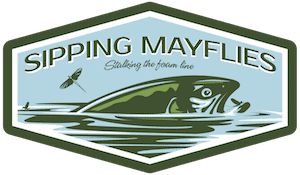Fly Fishing For Redfish
Tips and Tactics
September 18th, 2022
Sight fishing for redfish in shallow water is one of the biggest thrills in fly fishing–I can say this based upon personal experience. Redfish can attain a massive size, they’re very willing to take a fly, and they can be readily found throughout much of their range.
In essence, redfish (also called “red drum”) are the perfect gamefish for fly anglers to chase.
Whether you’re stalking redfish in a bayou, a flat, a delta, or in brackish or saltwater, the tactics I’m going to teach you remain the same.

Here’s a big redfish (Sciaenops ocellatus) I caught while fly fishing on the flats of Louisiana.
Redfish Range
Redfish (aka Red drum) are prolific fish and their range is expanding.
In the United States, redfish can be found living along the entire gulf coast, spanning all of Texas, Louisiana, Mississippi, Alabama, and Florida.
Their range also wraps around Florida (and the Florida keys) to the Atlantic coast, all the way up through the shores of Georgia, South Carolina, North Carolina, Virginia, Maryland, Delaware, New Jersey, New York, Connecticut, Rhode Island, and Massachusetts.
Now, let me be clear: their numbers aren’t equally distributed amongst the aforementioned states.
For instance, you’re going to find much higher concentrations of redfish in Texas and Louisiana than along the shores of Virgina and Maryland.
Additionally, the biggest redfish are found in Louisiana and Mississippi, but I’ve heard arguments that South Carolina has some hogs.
But, as I mentioned, their range is growing and scientists expect redfish to populate most of the Caribbean islands by 2050.
They already populate much of Mexico’s gulf coast.
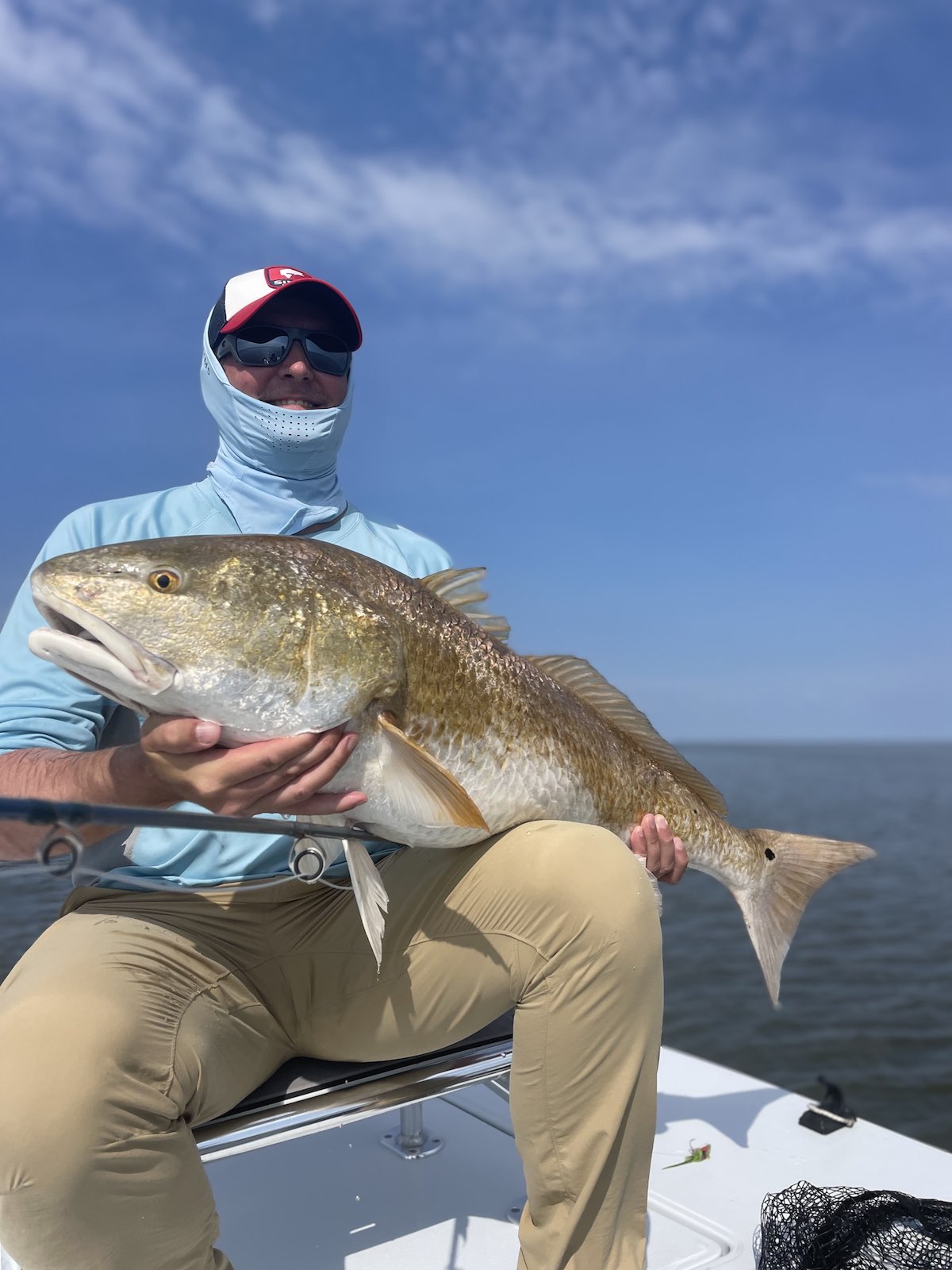
Here’s a picture of a big redfish I caught on the fly while sight-fishing in the Gulf of Mexico.

In the above picture, I’m doing some fishing from the shore in a Louisiana bayou. Notice the attentive alligators patrolling the area.
How to Find Redfish
When it comes to fly fishing, you’re going to want to look for redfish on the flats (shallow inshore expanses with a relatively even bottom), along mangroves and reeds, oyster beds, as well as on sand bars and shorelines.
All of the above spots are prime areas for spotting redfish. I wouldn’t even attempt to rank them, because they can all be excellent, depending upon conditions.
Watch for color
It’s worth mentioning that the biggest redfish tend to be a little farther off the shoreline. I’m talking 25-200 yards, not several miles. It’s here where you’ll want to constantly and attentively scan the water.
You’re watching for copper and orangeish glow, because that’s how redfish appear beneath the surface. Your eyes will learn to key-in on this color.
This is in contrast to black drum, which to my eye look like albino fish when they’re cruising 1-4 feet below the surface.
“V” Wakes
The most exhilirating moment when fly fishing for redfish is when you spot a “V” wake in the distance.
A “V” wake is just what it sounds like–a wake in the water shaped like the letter V. These wakes are created by large redfish that are cruising at or just below the surface of the water. Often times they’re traveling in pairs.
You can see “V” wakes along the shoreline, or even 200 yards offshore. Always be watching, since you can often spot these 100+ yards away.
The excitement comes from the anticipation. You’re watching the wake get closer and closer to you. You’re preparing for your cast. Your heartrate increases.
It’s like watching Jaws approaching.
I’ll explain the most effective stragegy for hooking into these fish in the next section.

Water Clarity
If the water is cloudy or even dirty, don’t worry too much about it. Redfish are still eating–you’ll just have to look a little harder. It should go without saying that you should always wear polarized sunglasses when stalking these fish.
In the above picture, I’m holding one of three redfish I caught in a small bay during a falling tide. The water was basically chocolate milk. But, we could still spot redfish along the shoreline where they were digging around the roots of plants lining the shore.
If it’s windy, the water may cloud-up a bit. In these cases, you can sometimes find areas protected from the wind with clearer water.
Watch for Birds
Always be scanning the horizon for birds. Specifically, sea gulls, terns, and pelicans.
This is critical.
Fishing guides are finely tuned to spot this activity.
These birds, when congregated above the water, are hovering over (and diving at) schools of baitfish. These same baitfish attract predatory fish, such as redfish. So, maneuver over to these spots when possible.
Sometimes you’ll find a school of redfish picking off baitfish from these gatherings.
A school of redfish can sometimes be followed and fished for up to 1-3 hours. Think about that.
These schools usually hold smaller and medium-sized redfish, but not usually bull reds (large redfish).
Baitfish
Speaking of baitfish, redfish frequently chase schools of mullet and menhaden, among others. If you see schools of small jumping fish, you can be sure they’re being chased by a predator.
If you can find the baitfish, you can find redfish.
Sharks on patrol
When you see sharks mulling around on the flats, the redfish will generally move in closer towards the shoreline.

Redfish generally have a single black spot on their tail, but this one I caught had several and was quite unique. I caught this fish while blind casting along a rocky jetty.
Mudding
When redfish dart away or get spooked, they leave a sizeable cloud of kicked-up dirt in the water. This activity is called “mudding” and seeing these clouds of silt is good sign that you’re in the right area.
Saltwater or brackish
Redfish area generally found in saltwater, but be sure not to rule out brackish water near freshwater deltas.
Specifically, a perfect example of this is where the mouth of the Mississippi river flows into the Gulf of Mexico, creating significant brackish areas. Plenty of redfish can be found in the nearby brackish bayous, flats, lagoons, and marshes. There are plenty of alligators too.
Plants and roots
If you can find plants such as reeds along the shoreline, there’s a decent chance you’ll happen upon some feeding redfish. They relish digging around the roots of plants.
If you see bunches of plants just off the shoreline, sort of like mini islands, make sure to check around them as well.
Specific states
Louisiana is the absolute best state for fly fishing for redfish. This isn’t debatable. There is no close second.
If you’re in Louisiana, you’ll have the added benefit of also chasing black drum (Pogonias cromis), crevalle jack (Caranx hippos), and sheepshead (Archosargus probatocephalus) with your fly rod.
Texas and Florida do have respectable redfish populations. Although, redfish in these states are, on average, smaller than what you’d find in Louisiana.
In Florida, the best place to cast flies for redfish is in Mosquito lagoon on the east coast of the state. The gargantuan flats there are full of redfish. A close second would be the Everglades.
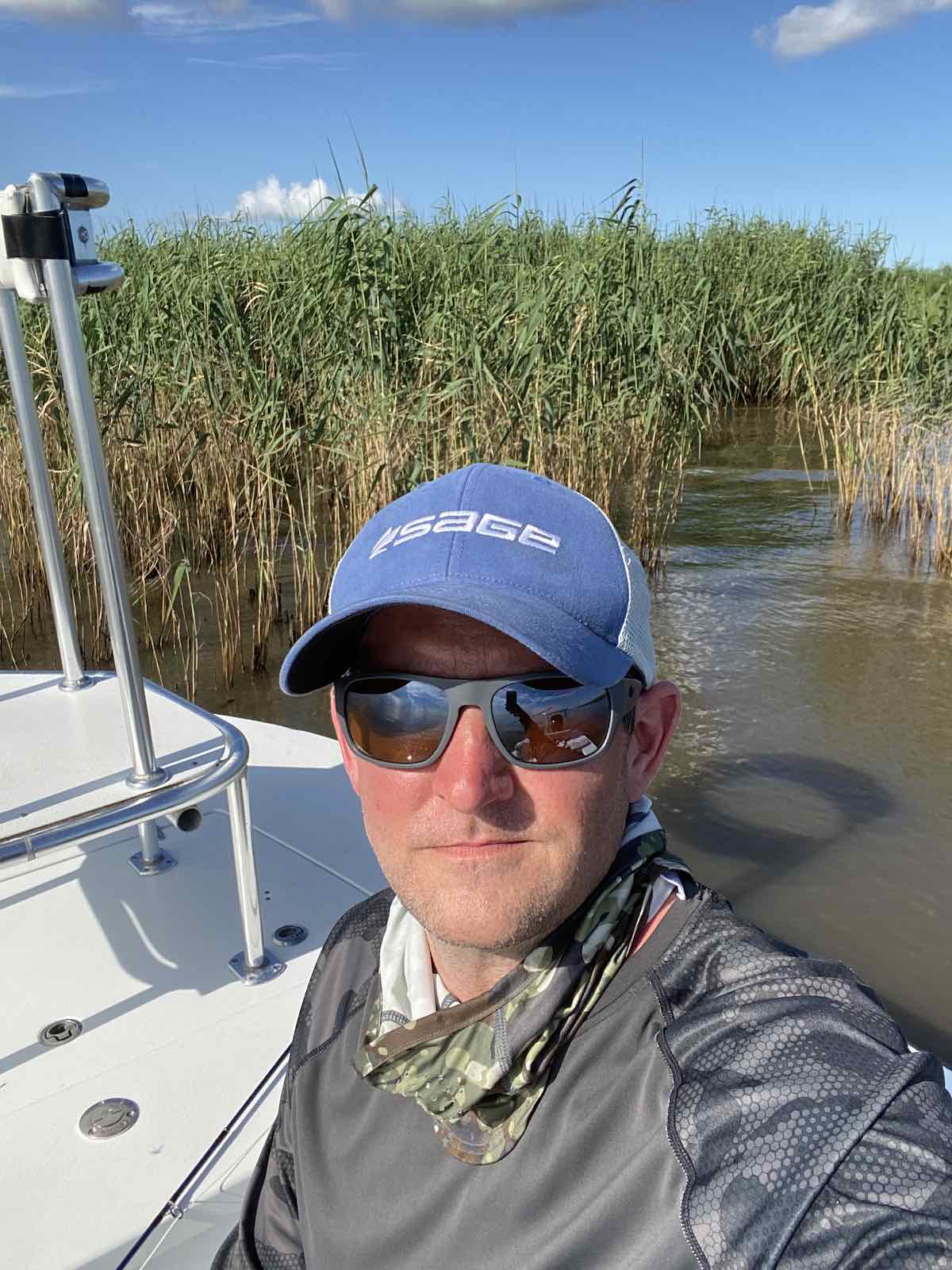
Stalking this weed-ridden Louisiana shoreline yielded many shots at redfish, and several in the boat. Always be watching for tailing fish.
Fly Fishing Tactics for Redfish
In the introduction I mentioned that redfish are prime fly fishing targets because they’re usually very willing to take a fly, you can sight-fish for them, and they generally don’t spook all that easily. Although, I’ve learned that Louisiana redfish spook less easily than in other places.
The most challenging part of the equation is simply finding the fish, which we covered in the preceding section.
In fact, I’ve gone hours without seeing a redfish, in Louisiana, in a boat, with a guide. It happens.
But, when you find them, it sure is exciting.
Wading or boating
A skiff is ideal for chasing reds. There’s nothing better.
Skiffs allow you to get into very shallow areas (less than 12-inches deep), and you can of course cover a ton of water as well.
But, not many folks have skiff boats, and guides are very expensive.
Wading along the shoreline, and in the flats, can be super productive.
You actually don’t even need to be in the water–redfish often forage in the surf and they get so shallow that their backs and tails are exposed. It almost looks like they’ll get beached, but they never do.
There are times when I’ve cast my fly from a skiff up onto the dry shoreline, and then stripped it down into the surf to the redfish.
Cruising fish
Most of the redfish you’re going to encounter will be moving–but not all of them.
I’ve seen some floating in stasis, like they’re sleeping. I’ve seen others anchored on the shoreline digging into the sand.
But generally speaking, most of the reds you come across will be moving. And, you’ll probably only get one shot at each fish. Once in a while you’ll get two. So, you need to make it count.
The reason I mention this is because it ties-in with our primary strategy.
When you see a redfish cruising, you want to calibrate its speed and cast your fly ahead of the fish. Lead it.
How much do you lead it by? That depends upon its speed and depth.
You want your fly to land directly in the redfish’s path, sink down from above, and then start stripping when you fly is at about the fish’s eye level.
Don’t strip like you’re fishing for jacks.
Keep it nice and steady, maybe 12-16 inches per strip at a medium-speed.
Redfish will often miss your fly but come after it again. So, don’t stop stripping or pull your line off the water if they miss initially.
When a fish takes your fly, do a very firm strip set. Don’t do a “trout set,” which is attempting to set the hook by lifting your rod.
A guide once physically demonstrated to me how much more powerful a strip-set is compared to a trout-set by having me hold the line while he held the rod. It was eye-opening.

Here I am in Louisiana with the biggest redfish I’ve landed on a fly rod. It was approximately 48-inches (we didn’t take the time to measure it), and nearly 40 pounds.
Fly presentation
Redfish are more forgiving when it comes to your presentation.
Instead of getting spooked when your fly plops hit’s the water near them, it can actually attract them. They seem inherently curious or inquisitive.
I once cast at a redfish near the shoreline and ended up snagged on a branch. We brought the skiff in close so I could dislodge my fly, and the redfish came back over to investigate. I could’ve touched the fish.
Casting tips
Some folks would try to dissuade you from false casting, for fear of spooking the reds, but based on my own experience it’s more of a positive than a negative.
False casting allows for a more accurate cast (and accuracy matters) and while I don’t use it in most situations, it comes in handy if I need to be more precise.
When you’re on the water, in a boat, or on the shore, getting a quick and accurate cast off can be challenging if you’re tossing weighted streamers. Hold the fly in your left hand (if you’re a righty), and always be ready.
If you inadvertently cast beyond the fish (too far), this is better than being too short. Here’s a real-life example.
I was in a skiff in the Gulf of Mexico casting towards a redfish that was cruising about six feet off the shoreline. I cast my fly too far–it went several feet past where I wanted it.
So, I did 2-3 very quick strips and got my fly right into position (in front of the fish’s head). I then did two shorter, medium-speed strips and the redfish tore at my fly and ate it. I did a strip-set and ended up landing the beast.
One more important tip is that when you’re in a boat, you’ll end up having to make quite a few very short casts of fewer than 10-feet. This is because redfish can seemingly come out of nowhere, and it’s harder than it sounds. In these cases, it’s more of a coordinated flip of your fly pattern. It’s a little awkward, but you get used to it.
Fighting the fish
When you hook into a redfish, it’s likely going to go on a short but powerful run. My fingers have been burned by the line on more than one occasion.
They don’t jump, they just pull like bulls.
Speaking of hard fighting fish, don’t miss my article on fly fishing for jack crevalle.
CRITICAL TIP: Don’t ever allow slack in your line while you’re fighting a fish. Especially a redfish. These fish have the uncanny ability to throw your fly the moment this occurs.
I know this from experience.
One beautifully calm day on a skiff off the coast of Louisiana I spotted a bull redfish just a few feet from the sandy shoreline. I was in position and made a decent cast. The fish inhaled my fly and I did a hard strip-set.
The fight was on.
Within seconds the fish bolted straight towards me and didn’t stop. Despite my furious efforts, I couldn’t strip line in fast enough and slack inevitably developed between myself and the redfish.
A couple seconds later the fish had thrown my fly.
Two other reds had thrown my fly on this particular trip, due to my not paying close enough attention to this vital rule.
While you’re fighting a redfish, make sure you’re using the butt of your rod, and not the tip, to exert pulling pressure. You can do this by pointing your rod in the general direction of the fish you’re fighting and pulling hard. Trust your gear and knots.
Also, if the fish goes left, you pull right. And vice versa. This will help tire the fish so you can land it quickly.

Sun and sight fishing
Sun and sight fishing go hand in hand. You want a bright sun to illuminate the water.
Without bright sunlight, seeing redfish (or any fish) under the surface of the water becomes considerably more challenging. Cloudy days can be tough.
A little breeze can be advantageous too.
Low tide techniques
If you can find a small bay that holds redfish, fish it once the tide begins falling.
With the advent of low tide, the water in the bay will start to drop as the water flows out. This present two prime opportunities for a fly angler.
The first technique involves anchoring your skiff at the entrance to the bay, and casting to redfish as they swim by you for deeper water.
The second technique involves patrolling the shorelines of the bay. As the water becomes more shallow with the outgoing tide, the remaining redfish will become more visible.
Once when I was engaging in technique #2, I saw a giant alligator gar surface about 10-feet from my boat. I cast to the fish but it didn’t take my fly.
A lowering tide is my favorite time to cast flies for redfish.
Best time of year for redfish
Redfish can be caught any time of year, especially in places like Louisiana. Truly, there are no “bad” months.
With that said, during the winter (December, January, and February) the bull reds congregate in the shallows where the water is warmer.
It’s worth mentioning that the hurrican season for states bordering the Gulf of Mexicao is August 1st through November 1st, with early September being the peak.
Noise factor
While redfish aren’t particularly spooky fish, you still want to avoid unnecessary noise.
Specifically, if you’re standing at the bow of your boat, don’t rock back-and-forth when you’re casting. This swaying causes tiny waves in the water that can be felt by fish using their lateral line.
Cast with your upper body only.
Keep noise to a minimum. Stay still and move your head, not your body, as you scan the water.
Jetties
Rocky jetties are my favorite place to blind cast for redfish. It makes sense, because small fish and crustaceans seek out the relative protection that rocks provide. And where there is food, you’ll find predatory fish.
My general strategy is simple and productive.
I cast a weighted streamer, wait a few seconds for it to sink several feet, and then start stripping. It’s a surprisingly effective method.
Part of why I like fly fishing around jetties is because you never know what you’re going to catch. It adds an element of anticipation each time you hook into something.
A few weeks ago while I was blind fishing a jetty, I caught a nice-sized redfish, two ladyfish, and a sand sea trout within about ten casts.
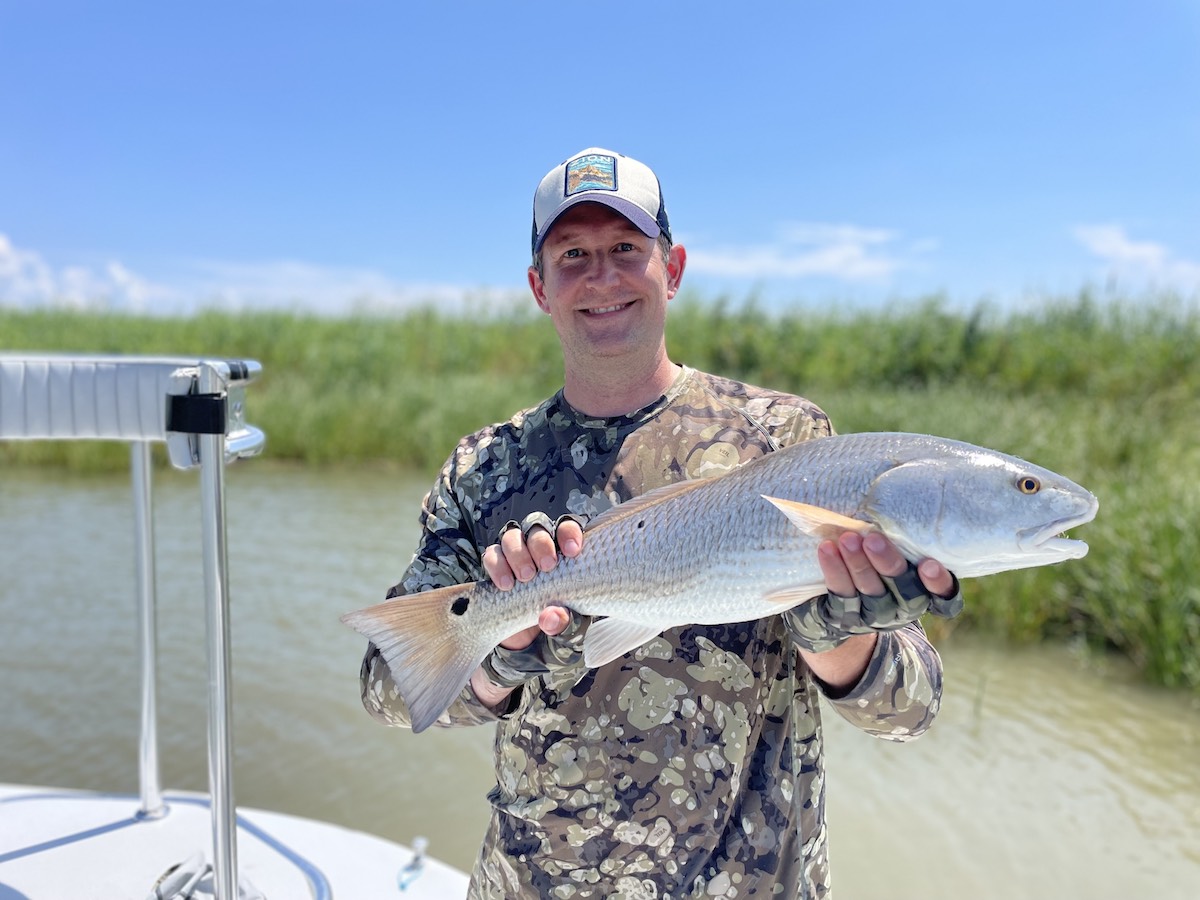
Here’s one of several redfish I caught in a small bay during a falling tide. (The same bay where I saw the giant alligator gar.) This fish was visible near the shoreline.
The Best Redfish Flies
Streamers
Streamers are what most fly anglers use to catch redfish.
You can use floating streamers (usually imitating shrimp), or streamers that slowly sink, or streamers that sink quickly. It just depends upon where the fish are feeding in the water column.
As I’ve mentioned, redfish aren’t picky eaters. Your imitations don’t need to be spot-on. Just somewhat within the realm of reasonable.
If they’re feeding on crabs, toss a sinking crab fly.
My go-to fly pattern is the weighted clouser minnow, and several variations of it. Usually 3-5 inches long. Again, don’t get too caught-up on specific patterns or colors. A little red accent, perhaps imitating blood or gills, can be effective.
The everglades special and the kinky muddler are great redfish flies too. You can get a deadly assortment of affordable redfish flies on this page at Amazon.
I’m not a huge fan of weedless flies, but once in a while they come in handy.
Experiment. Some days they’ll eat anything you throw in front of them, and other days they’re somewhat more selective.
Ask 10 guides what they’re favorite fly is, and you’ll certainly get 10 different answers.
Poppers
If you fish often enough, you’ll eventually have an opportunity to cast to redfish that are eating on the surface. This is usually when you come across a school.
In cases like this, you use big poppers that move a lot of water. Not medium-sized poppers…big poppers. Green, white, and brown are my go-to colors.
You cast your popper amongst the feeding fish, and strip it with purpose. Not too fast though. Redfish are comical when they try to eat a fly on the surface.
They might miss your popper the first time, but keep stripping at an even pace and they’ll come back for it in all likelihood.
Their mouths are huge, and this is a really fun way to catch them. You can get some great refish poppers on this page at Amazon.
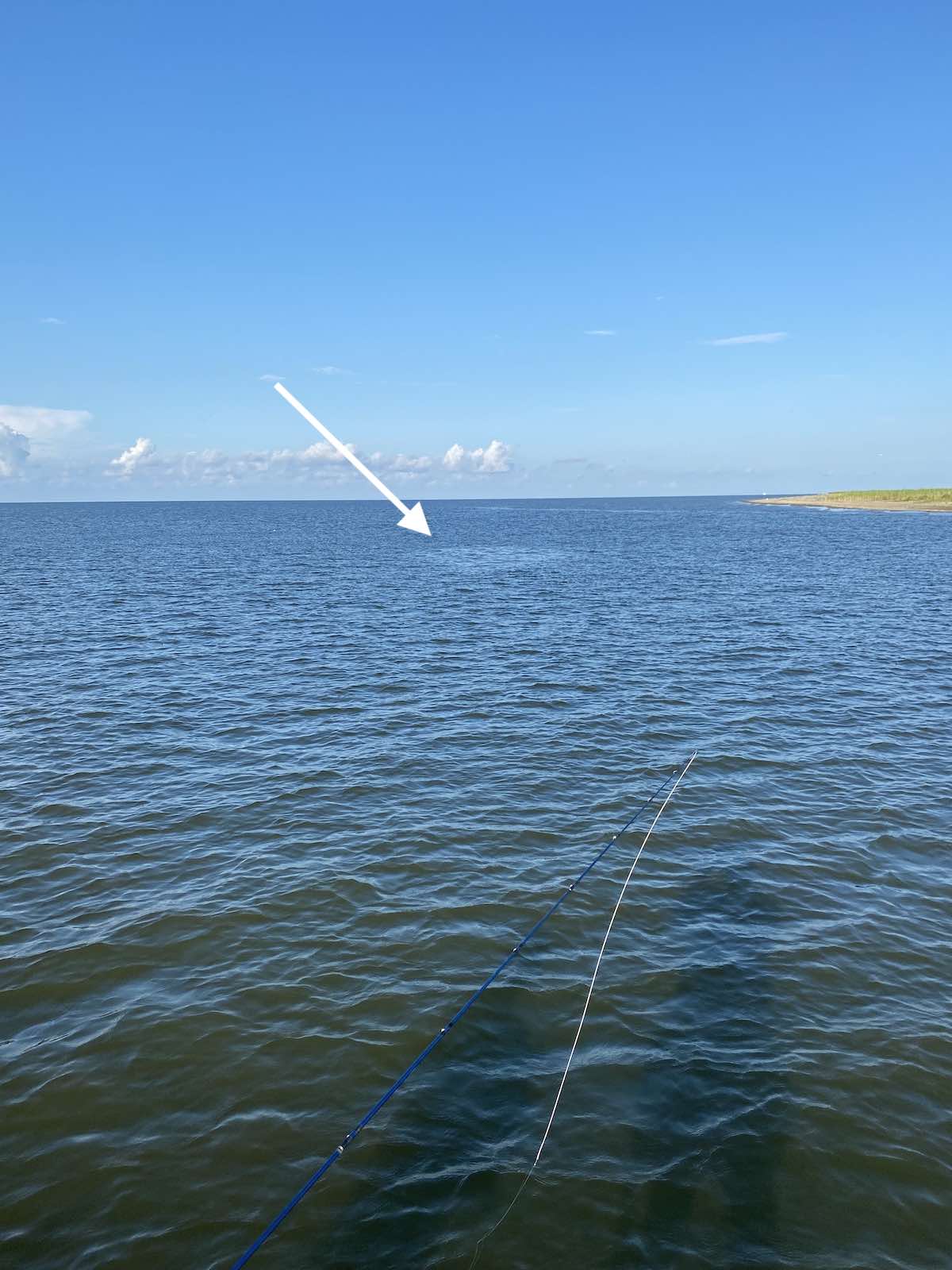
Here’s a picture I took showing a slick on the water (I added an arrow). This slick comes from schools of baitfish being demolished by predatory fish, resulting in considerable fish oil being released.
Recommended Fly Gear
Fly Rods
There’s relatively little debate about what fly rods are appropriate for redfish.
You’re going to want a 9-foot rod of either 9 or 10-weight, and make sure it has a fighting butt.
You could get away with using a 7 or 8-weight rod for small and medium-sized redfish, but keep in mind that heavier rods really help you cast big flies in the wind. And there’s almost always some wind.
A heavier rod will also allow you to land fish more quickly, which is much better for the fish.
So, go with a 9 or 10 weight rod. Fast action is my personal preference.
Fly Reels
When you’re in the salt, your reel matters.
You want something of high quality–specifically, a top-notch drag system. Redfish (and many other species) will give it a workout.
I use a Sage Spectrum Max, but there are many other fine fly reels on the market.
Fly Line
You’re going to want a weight-forward floating fly line for chasing redfish.
You don’t need (or want) full sinking line.
Rio has a “Redfish” fly line available, but I’ve never used it before. It sounds great, though, since it has a quick loading head for very short casts (which are very commonly required).
Leader & Tippet
You’ll want to use a leader that’s 5-9 feet in length. The strength of the line is personal choice.
Most redfish anglers use 20lb to 40lb line.
My preference is to use 20lb line. Generally I use fluorocarbon, but I’ve used monofilament as well. Fluorocarbon sinks better than mono, is less visible, and is noticeably stronger.
Redfish aren’t toothy like a barracuda, and I’ve never had one break me off. Knock on wood.

Here I am scanning the Louisiana flats for redfish, crevalle jack, black drum, and sheepshead.
Hiring a Guide
If you want to make the most of your time, hire a guide who specializes in fly fishing for redfish.
Yes, it’s expensive. You can bank on paying $600-$800 per day. Generally, this price covers up to two anglers, not including the guide. Most skiffs aren’t equipped to handle three anglers plus a guide.
The price I mentioned above is for a “full day,” which means different things to different people. The last time I was in Louisiana, I met my guide at 7am, and we got back to the dock at 4:30pm or thereabouts. That’s 9.5 hours.
I’ve been on guided trips for trout where a full day was six hours of actual fishing, and two hours of travel.
So, make sure you ask questions before booking. Read my article on how to hire a fly fishing guide.
Going out alone means you get to fish the entire time. If you go out with a friend, you’re going to be splitting time. There’s only room for one person to fish at a time.
Often times you’ll switch with the other angler once you catch a fish, or once you miss a fish, or after a predetermined amount of time (30 minutes, for example). You can make it a game.
Jeff Currier once said something on a podcast that I’ve never forgotten.
He often gets asked about the best time to fly fish for various species, and he said it’s a tough question to answer because if you go on the same fishing trip five years in a row, one of the trips will eclipse your wildest expectations, three of the trips will meet your expectations, and one of the trips will be a disaster (rain, hurricane, etc).
Redfish Conservation
During my most recent trip to Louisiana, my fly fishing guide told me that 20 years ago when he began guiding, the fishing was far better. Incomprehensibly so.
While the redfish are still numerous in many flats, marshes, and bayous lining the Gulf of Mexico, their numbers have dropped significantly.
Aside from the usual culprit (pollution), he said there were two primary reasons for the decline in redfish populations:
- Foreign (and domestic) companies are allowed to harvest vast quantities of menhaden for their fish oil. Menhaden are a primary food for many predatory fish, and their numbers have been decreasing noticeably.
- Louisiana currently allows the harvest of five redfish per person, per day. Considering their size, this is profligate waste.
Specifically, the state of Louisiana allows each angler to keep five redfish between 16″ and 27″, and of the five fish, one fish can exceed the 27″ length limit.
So, theoretically, one angler could keep four 27″ redfish, and one 40″ redfish, every single day of the year.
That’s absolutely preposterous.
They also allow each angler to keep 25 speckled sea trout per day. Yes, you read that correctly. 25!
Summary
Sight fishing for redfish (red drum) is unquestionably one of the most exciting things you can do with a fly rod in your hand. Watching a bull red slowly swimming in your direction is a real thrill. I highly recommend it.
The best place to chase big, cooperative redfish is in Louisiana. Texas, Mississippi, and Florida have some great spots too, albeit smaller fish on average, and usually spookier.
Hiring a guide with a skiff is the most productive way to chase redfish, but wading the shallows works too. Either way, you’re going to have a great time!
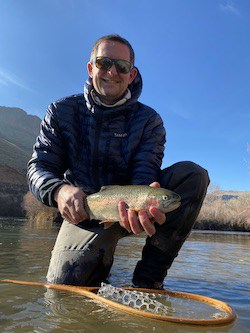
About the Author
My name's Sam and I'm a fly fishing enthusiast just like you. I get out onto the water 80+ times each year, whether it's blazing hot or snow is falling. I enjoy chasing everything from brown trout to carp, and exploring new waters is something I savor. My goal is to discover something new each time I hit the water. Along those lines, I record everything I learn in my fly fishing journal so I can share it with you.
